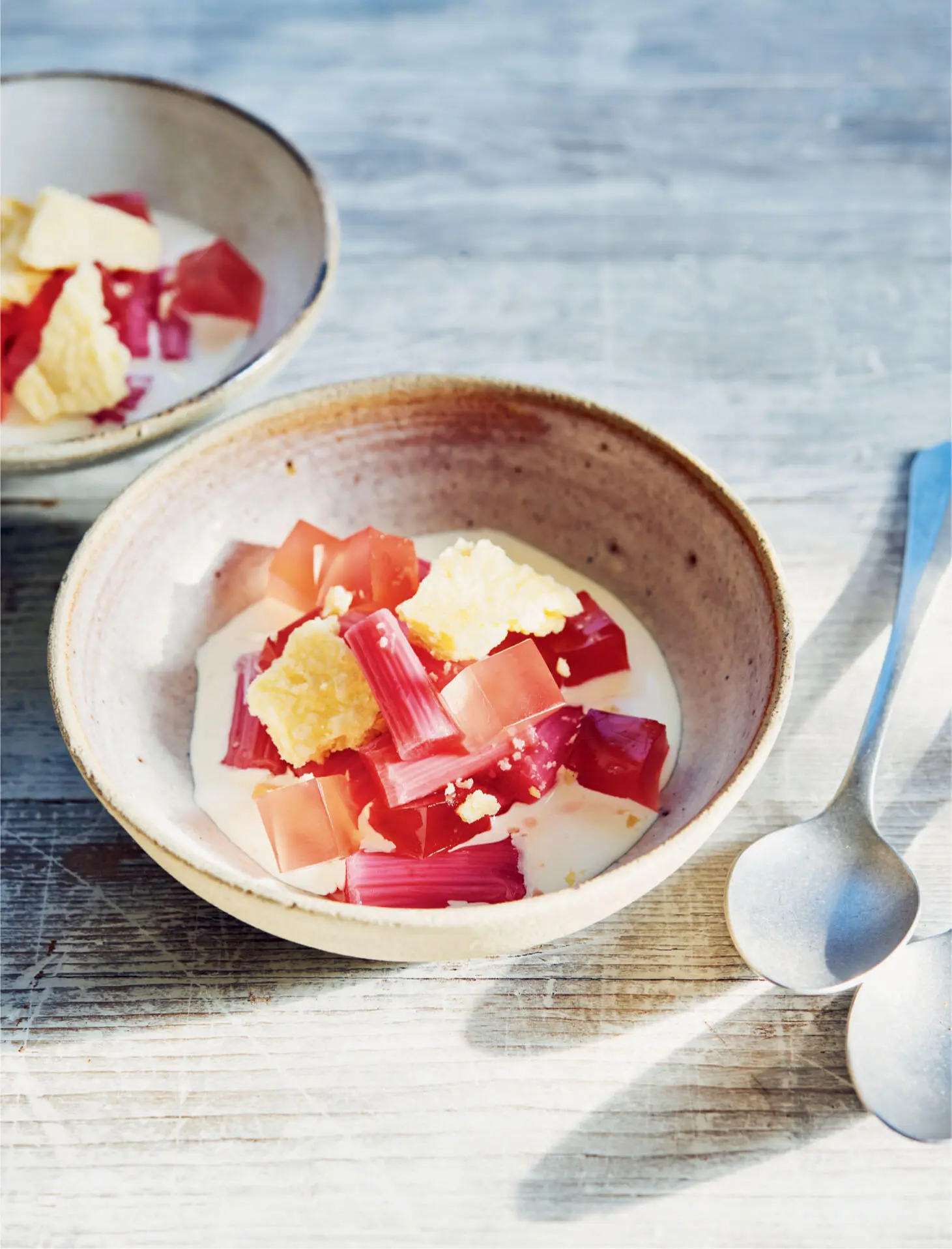2 Preheat the oven to 200°C/180°C fan/gas 6.
3 Place a layer of parsnip slices on the bottom of a 20 × 20cm baking dish, then cover with a little of the milk mixture. Repeat, ensuring the parsnips are fully submerged in the liquid. Cover the entire dish with foil and bake for 25 minutes. Remove the foil and bake for a further 20–25 minutes until a knife inserted into the gratin meets no resistance.
4 Remove from the oven and serve.
MARCUS’ TIP:
I prefer a roast dinner with one side done really well, rather than three or four different vegetables on the plate – one great dish like this one that has a bit more effort put into it makes it much more interesting. Nothing wrong with that.
Celeriac, Ham Hock and Barley Hot Pot
As far as winter warmers go, this one ticks all the boxes. Celeriac is such a versatile ingredient, to serve both raw and cooked. It is a winter staple for me and it pairs well with the salty, rich ham hock in this recipe. Just add some fresh bread and you have a great winter’s lunch or supper. Always remember to bring ham hocks to the boil in a pan of water then drain them before cooking, otherwise they will be too salty.
SERVES: 4–6 | PREP TIME: 10 MINUTES | COOKING TIME: ABOUT 3¾ HOURS
1 smoked ham hock (about 1kg)
½ bunch of thyme, tied with string
200g pearl barley, rinsed
100g yellow split peas, rinsed
1 celeriac, peeled and roughly chopped
4 onions, roughly chopped
4 carrots, peeled and roughly chopped
1 leek, rinsed and roughly chopped
½ bunch of flat-leaf parsley, leaves roughly chopped
freshly ground black pepper
1 Place the ham hock in a large saucepan and cover with cold water. Bring to the boil, then drain and rinse the ham under cold running water. Place the ham back in the pan, cover with fresh cold water and add the thyme and a generous grind of black pepper. Place over medium heat, bring to a simmer and cook, uncovered, for 2½ hours, topping up the water to ensure the ham is always submerged.
2 Add the pearl barley and split peas and cook for a further 30 minutes.
3 Check to see if the hock is cooked by putting the handle of a spoon into the flesh: if the handle meets no resistance, the meat is cooked. If the meat doesn’t yet yield to the spoon handle, continue to cook it, checking every 15 minutes. Remove the hock, add the remaining ingredients, apart from the parsley, and simmer for a further 30 minutes.
4 Using two forks, remove the skin from the hock, discard it and shred the meat. Return the meat to the pot and simmer gently for 5 minutes. Check the seasoning and adjust if necessary. Remove the bunch of thyme.
5 Finish with the parsley and serve.
Poached Rhubarb and Rhubarb Jelly with Bay Leaf Cream and Shortbread
Rhubarb, jelly and cream. So simple, yet so delicious. The bay leaf infusion in the cream adds a savoury element to the dish which balances the sweetness of the rhubarb and shortbread. During rhubarb season I generally always have some poached in the fridge – it is great to have with cereal for breakfast, to use in baking and also as a simple pudding. Who doesn’t like rhubarb and jelly?
SERVES: 6 | PREP TIME: 25 MINUTES, PLUS SETTING AND INFUSING | COOKING TIME: ABOUT 15 MINUTES
200g caster sugar
2 tbsp grenadine
400g rhubarb stalks, trimmed and cut into 4cm lengths
3 gelatine leaves
FOR THE BAY LEAF CREAM
100ml milk
2 bay leaves
300ml double cream
FOR THE SHORTBREAD
70g plain flour
50g cornflour
40g icing sugar, sifted
pinch of sea salt
90g cold diced butter
1 To cook the rhubarb, put the caster sugar and grenadine in a large saucepan. Top up with 500ml water and bring to a simmer over medium heat, stirring to dissolve the sugar. Place the rhubarb pieces in the hot liquid and simmer for 5 minutes, then remove the pan from the heat and allow the rhubarb to continue to cook in the liquid for 10 minutes, as it cools down. Carefully transfer the rhubarb from the liquid into a bowl using a slotted spoon and place in the fridge to cool. Measure out 400ml of the cooking liquor, place it in a medium saucepan and set aside.
2 To make the jelly, soak the 3 gelatine leaves in a bowl of cold water for 5 minutes. Heat the 400ml of rhubarb cooking liquor until it just reaches the boil, then remove the pan from the heat. Squeeze the excess water from the gelatine leaves and stir them into the hot liquid until completely dissolved. Strain the liquid into a clean container lined with baking parchment (around 15cm square), which gives the jelly at least 1cm height, and chill until set. Remove from the container and cut into squares.
3 For the bay leaf cream, heat the milk in a small saucepan. Break up the bay leaves and add them to the milk. Remove from the heat as soon as it reaches the boil. Cover the surface of the milk with clingfilm and set aside to infuse for 20 minutes. Using a stick blender, blitz the milk to disperse the leaves, strain and place in the fridge to cool. Once cool, mix in the double cream.
4 To make the shortbread, preheat the oven to 200°C/180°C fan/gas 6 and line a baking tray with baking parchment.
5 Put all of the dry ingredients in a food processor and blitz to combine. Add the butter and pulse in short bursts until you have a dough that clumps together in little bits. It may take some time to incorporate the butter into the dry ingredients. Tip onto a clean surface and work together. Place on the lined baking tray and shape into a rectangle about 6mm thick. Bake in the oven for 10–12 minutes until a pale golden colour. Remove from the oven, allow to cool slightly, then break up into pieces.
6 To serve, divide the the cream and rhubarb pieces among 6 bowls. Top with the jelly and shortbread pieces.
MARCUS’ TIP:
Make a double batch of shortbread and freeze half of the dough, ready to bake another day.

Strawberry and Mint Eton Mess
Eton mess, said to have originated from Eton when a tray of meringues was dropped on the floor, is a great summer pudding. This is more of a ‘make your own mess’ pudding – the presentation is neat and tidy then you create your own mess by smashing it. All the fun’s inside but you can’t initially see it. The mint gives the dish a freshness which helps cut through the sweetness of the meringue.
SERVES 4 | PREP TIME: 25 MINUTES | COOKING TIME: 1 HOUR
350g strawberries, hulled
25ml vodka
2 tbsp strawberry jam
200g double cream, lightly whipped
12 mint leaves, finely sliced
FOR THE MERINGUE
1 lemon wedge
4 egg whites, at room temperature
110g caster sugar
110g icing sugar, sifted
1 Preheat the oven to 120°C/100°C fan/gas ½ and line a large baking sheet with non-stick baking parchment. Draw 4 × 10cm circles on the paper.
2 To make the meringue, rub the lemon wedge around the inside of a clean mixing bowl or the bowl of a stand mixer. Add the egg whites and whisk on high speed until they form stiff peaks. Decrease the mixing speed to medium and gradually add the sugar, whisking continuously. Increase to high speed and whisk for 5–10 minutes until you have a stiff meringue and all grains of sugar have dissolved. Add the icing sugar and whisk until well combined.
3 Place the meringue into a piping bag, and pipe into the centre of each circle on the parchment-lined baking sheet to form a dome. Create 3 more domes.
Читать дальше













